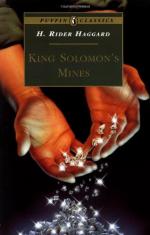Presently she stopped and pointed at the brown object seated on the table. Sir Henry looked, and started back with an exclamation; and no wonder, for there, quite naked, the head which Curtis’ battle-axe had shorn from the body resting on its knees, was the gaunt corpse of Twala, the last king of the Kukuanas. Yes, there, the head perched upon the knees, it sat in all its ugliness, the vertebrae projecting a full inch above the level of the shrunken flesh of the neck, for all the world like a black double of Hamilton Tighe.[*] Over the surface of the corpse there was gathered a thin glassy film, that made its appearance yet more appalling, for which we were, at the moment, quite unable to account, till presently we observed that from the roof of the chamber the water fell steadily, drip! drop! drip! on to the neck of the corpse, whence it ran down over the entire surface, and finally escaped into the rock through a tiny hole in the table. Then I guessed what the film was—Twala’s body was being transformed into a stalactite.
[*] “Now haste ye, my handmaidens, haste and
see
How he sits there and glowers
with his head on his knee.”
A look at the white forms seated on the stone bench which ran round that ghastly board confirmed this view. They were human bodies indeed, or rather they had been human; now they were stalactites. This was the way in which the Kukuana people had from time immemorial preserved their royal dead. They petrified them. What the exact system might be, if there was any, beyond the placing of them for a long period of years under the drip, I never discovered, but there they sat, iced over and preserved for ever by the siliceous fluid.
Anything more awe-inspiring than the spectacle of this long line of departed royalties (there were twenty-seven of them, the last being Ignosi’s father), wrapped, each of them, in a shroud of ice-like spar, through which the features could be dimly discovered, and seated round that inhospitable board, with Death himself for a host, it is impossible to imagine. That the practice of thus preserving their kings must have been an ancient one is evident from the number, which, allowing for an average reign of fifteen years, supposing that every king who reigned was placed here—an improbable thing, as some are sure to have perished in battle far from home—would fix the date of its commencement at four and a quarter centuries back.
But the colossal Death, who sits at the head of the board, is far older than that, and, unless I am much mistaken, owes his origin to the same artist who designed the three Colossi. He is hewn out of a single stalactite, and, looked at as a work of art, is most admirably conceived and executed. Good, who understands such things, declared that, so far as he could see, the anatomical design of the skeleton is perfect down to the smallest bones.
My own idea is, that this terrific object was a freak of fancy on the part of some old-world sculptor, and that its presence had suggested to the Kukuanas the idea of placing their royal dead under its awful presidency. Or perhaps it was set there to frighten away any marauders who might have designs upon the treasure chamber beyond. I cannot say. All I can do is to describe it as it is, and the reader must form his own conclusion.




